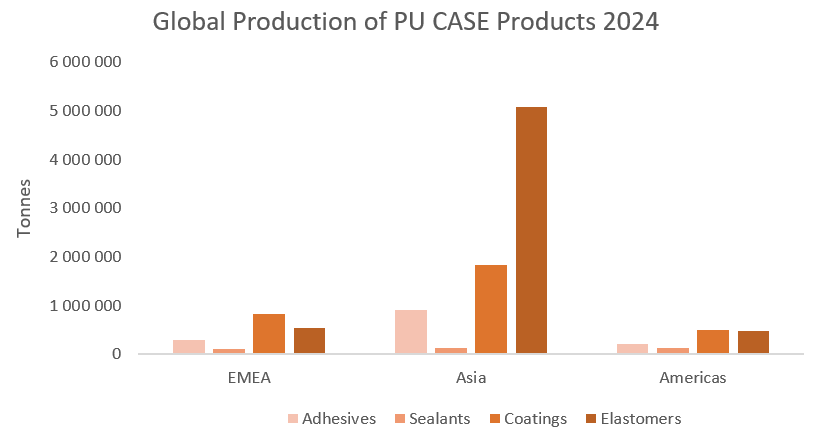Global Shift to Eco-Friendly Polyurethane: Market Trends in Polyols and Isocyanates Across EMEA, APAC, and Americas
- ial
- Nov 18
- 3 min read
Polyurethane (PU) foam is widely employed in furniture, mattresses, automotive interiors, building insulation, appliances, footwear, and several other industries. The industry is subtly shifting towards sustainable methods of production, driven by regulatory pressure and increasing expectations from downstream manufacturers and consumers. Across, Asia, Europe, and the Americas, producers are progressively adopting more environmentally responsible practices to reduce carbon emissions, enhance circularity, and minimize reliance on fossil-based feedstocks.
Raw Material Production
The regional development of the eco-friendly polyols and isocyanates market has evolved based on regulatory ambition, industrial maturity, and sustainability integration. Europe, Middle East, and Africa (EMEA) historically dominated eco-friendly polyol production due to strong environmental policies—such as REACH and the European Green Deal—supported by advanced R&D, circular economy goals, and rapid commercial adoption of mass-balanced and low-carbon materials, with the region having 3.5% as the current eco-friendly polyol market share and is further expected to retain the largest share by 2034. However, Asia-Pacific (APAC) is projected to be the fastest-growing market, driven by expanding polyurethane demand in automotive and construction sectors, rapid industrialisation, and rising investment in green technologies in China, Japan, and South Korea, positioning APAC to reach approximately 35% of global eco-friendly polyol production by 2034. The Americas are likely to exhibit the slowest transition, achieving only around 17% share due to limited regulatory pressure, lack of commercial chemical recycling infrastructure, and slow adoption of sustainable production practices.
Similarly, in eco-friendly isocyanates, Europe initially led based on strict environmental mandates and corporate sustainability commitments, whereas APAC’s contribution remained relatively low because of cost-driven markets and moderate regulatory requirements. Nonetheless, as awareness and technological upgrades increase, APAC is expected to close the gap, with its eco-friendly isocyanates market share projected to rise, nearly matching EMEA. Ultimately, while EMEA will remain a key innovator, APAC is positioned to surpass Europe in future production capacities for both eco-friendly polyols and isocyanates, reshaping global market leadership.

Polyurethane Products
The adoption of eco-based technologies in PU segments—including flexible foam, rigid foam, elastomers, thermoplastic polyurethane (TPU), and coatings, binders and adhesives—is steadily expanding as sustainability gains prominence across industries such as furniture, automotive, construction, footwear and consumer goods.
Flexible PU foams are increasingly incorporating renewable polyols, recycled content and mass balance-certified inputs to reduce environmental impact while retaining comfort and performance, though growth is moderated by high costs, limited commercial-scale bio-based feedstock availability and transition-related technical challenges. In 2024, EMEA leads flexible foam adoption with a market share of around 7.5%, expected to surpass 50% by a significant margin by 2034, followed by APAC and the Americas.
Similarly, eco-based rigid foams also have a similar market dynamic in insulation and construction applications where energy efficiency is paramount, but the shift remains technically complex due to high performance requirements. EMEA dominates this segment, enabled by stringent green building regulations and significant R&D investments, while APAC is catching up through rapid urbanisation and policy support, and the Americas continue to lag.
Eco-based elastomers are seeing gradual uptake in automotive, footwear and industrial goods, driven by goals to reduce greenhouse gas emissions and fossil dependency, but adoption is constrained by cost and performance limitations. Europe leads innovations, APAC follows with strong government and brand-backed sustainability agendas, and the Americas remain slower-moving.
Eco-based TPU adoption is also rising, particularly in Europe where environmental regulations and strong consumer awareness spur growth, while APAC demonstrates rapid progress, and the Americas show early-stage momentum. In coatings, binders and adhesives, adoption remains negligible globally due to high cost, performance concerns and fragmented regulatory frameworks, though EMEA again leads advancement via mass balance approaches and circular economy initiatives. Across all segments, while EMEA continues to drive innovation and early adoption, APAC is positioned for rapid expansion, whereas the Americas require stronger regulatory and infrastructural support to accelerate progress.
You can find the report in our shop:
For more information, please contact ial@brggroup.com
IAL Consultants (A Division of BRG Enterprise Solutions Ltd)
CP House, 97-107 Uxbridge Road, Ealing, London W5 5TL
Tel: +44 (0) 20 8832 7780




Comments